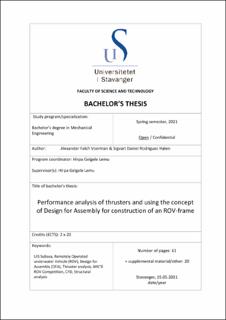| dc.contributor.advisor | Lemu, Hirpa Gelgele | |
| dc.contributor.author | Høien, Sigvart Daniel Rodriguez | |
| dc.contributor.author | Voerman, Alexander Falch | |
| dc.date.accessioned | 2021-09-07T16:28:04Z | |
| dc.date.available | 2021-09-07T16:28:04Z | |
| dc.date.issued | 2021 | |
| dc.identifier | no.uis:inspera:78876263:35685227 | |
| dc.identifier.uri | https://hdl.handle.net/11250/2774335 | |
| dc.description.abstract | This thesis aimed to develop an ROV-frame based on the concept of Design for Assembly, while conducting a performance analysis of the thrusters to be used for its required motion. The development of the ROV-frame and the analysis of the thrusters would assist UiS Subsea in their development of the ROV to compete in the 2021 MATE ROV competition. More specifically, the frame design incorporated an iterative process where its components were analysed by how essential they were for the operation of the ROV. The concept of Design for Assembly gave good results in design efficiency and through the assembly fitment process, but worse in terms of cost, quality of design and assembly time. This is due to the fact that only one unit was produced, of which the Design for Assembly concept calculations is more aimed at a production line.
Throughout the design, considerations have been given to the implementation of external equipment from other teams in UiS Subsea. The frame had to incorporate enough space for the number of thrusters needed, and the materials needed for the frame was evaluated based on weight, tensile strength, and density. Calculations have been performed of centre of gravity and centre of buoyancy, structural calculations and analysis of screw connections, welds, 3D-printed parts, and metals used in the construction of the frame. By doing these calculations, the components used in the frame were found to be more than strong enough with a weight distribution that provides good stability under water.
Through the performance analysis of thrusters, different angles and configurations were considered, and a setup that gave the desired manoeuvrability was found. This was proved through manual vectorial calculations, which were further used in a computational fluid dynamics analysis where the dynamic properties of the frame gave good results. Through this, the ROV’s coefficient of drag was derived, and a maximum speed in ideal conditions underwater was found. | |
| dc.description.abstract | This thesis aimed to develop an ROV-frame based on the concept of Design for Assembly, while conducting a performance analysis of the thrusters to be used for its required motion. The development of the ROV-frame and the analysis of the thrusters would assist UiS Subsea in their development of the ROV to compete in the 2021 MATE ROV competition. More specifically, the frame design incorporated an iterative process where its components were analysed by how essential they were for the operation of the ROV. The concept of Design for Assembly gave good results in design efficiency and through the assembly fitment process, but worse in terms of cost, quality of design and assembly time. This is due to the fact that only one unit was produced, of which the Design for Assembly concept calculations is more aimed at a production line.
Throughout the design, considerations have been given to the implementation of external equipment from other teams in UiS Subsea. The frame had to incorporate enough space for the number of thrusters needed, and the materials needed for the frame was evaluated based on weight, tensile strength, and density. Calculations have been performed of centre of gravity and centre of buoyancy, structural calculations and analysis of screw connections, welds, 3D-printed parts, and metals used in the construction of the frame. By doing these calculations, the components used in the frame were found to be more than strong enough with a weight distribution that provides good stability under water.
Through the performance analysis of thrusters, different angles and configurations were considered, and a setup that gave the desired manoeuvrability was found. This was proved through manual vectorial calculations, which were further used in a computational fluid dynamics analysis where the dynamic properties of the frame gave good results. Through this, the ROV’s coefficient of drag was derived, and a maximum speed in ideal conditions underwater was found. | |
| dc.language | eng | |
| dc.publisher | uis | |
| dc.title | Performance analysis of thrusters and using the concept of Design for Assembly for construction of an ROV-frame | |
| dc.type | Bachelor thesis | |
